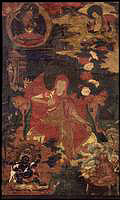
|
Lama Sakya Pandita (painting no. 356)
|

View Larger Image |
||||||||||||||
|
Sakya Pandita and retinue I. Main figure a. Name: Sakya Pandita Kunga Gyaltsen (sa skya pan di ta kun dga' rgyal mtshan, 1182-1251) Sakya Pandita Kunga Gyaltsen (sa skya pan di ta kun dga' rgyal mtshan) is the main figure of the Sakya lineage. He was the main the 6th throne holder of Sakya and the great grand son of Kunga Nyingpo. /to be completed. II. Surrounding figures: 1) The Wheel of the Teachings (bstan pa'i 'khor lo), a name of Manjushri. 2) Jetsun Trakpa Gyaltsen (rje btsun grags pa rgyal mtshan, 1147-1216), 5th throne holder of the throne of Sakya, son of Kunga Nyingpo. 3) Four Faced Mahakala (mgon po gzhal bzhi pa) 4) The heretic teacher Trokchey Gapo ('phrog byed dga' po), who was defeated in debate and miracle contests by Sakya Pandita. M Ricard 1/98 From a series of blockprint thangkas produced at Narthang depicting previous incarnations of the Panchen Lama. M. Mokotoff 1/98 SAKYA PANDITA, Kunga Gyaltsen Pal Zangpo (1182-1251), the sixth throne holder of Sakya, debating with the Indian Tirthika Harinanda. In a vigorous posture of debate, wearing a red pandita hat and attired in the patched robes of a fully ordained monk, Sakya Pandita performs the debating gestures of snapping the fingers of the right hand prior to clapping with the left. The right leg drawn up and the left pendant, supported by a step, he sits atop a yellow cushion seat with an elaborate backrest adorned with dragon heads; draped in ornate brocades. To the right a flowering bush with alternating white and red blossoms forms a symbolic staircase to the guru above. In front to the lower right sits the naked Indian Harinanda, brown, with long twisted hair, seated on an antelope skin, attended by a servant with a white turban. To the left and back of Sakya Pandita, against a green lush and varied landscape, unfolds a temple scene before a standing image with worshippers offering wicks of flaming butter in golden lamps. At the top left is the patron deity of Sakya Pandita, the bodhisattva Manjushri, Sthiracakra, with one face and two hands holding a wisdom sword and lotus supporting a Prajnaparamita book; seated within a glowing nimbus sphere of emanated light. At the right is the root guru and uncle, Jetsun Trakpa Gyaltsen (1147-1216), holding a vajra extended in the right hand and a bell turned up at the waist in the left. Attired in the variously coloured garments of a layman, seated on an ornate cushion with a backrest, he resides above gently spreading clouds. At the bottom left is the protector of the Guhyasamaja Tantra, Chaturmukha Mahakala (the Four Faced Black Lord), wrathful visage of Brahman Mahakala, with four hands and charnel ground vestments of skins and bones, he stands upon a corpse seat amidst the swirling flames of pristine awareness. Inscription along the bottom front: "With the compassion of the great Jetsun Trakpa Gyaltsen and the tutelary deity Sthiracakra, Sakya Pandita defeated the Tirthikas with the assistance of the wrathful Four-faced One." Historical Background: After the Sanskrit publication of Sakya Pandita’s definitive treatises on Buddhist logic, the ‘Tse ma rig pi ter,’ his fame spread throughout eastern, western and central India. Wishing to debate with Sapan, six Indian Tirthika pandits with Harinanda at the lead traveled to Kyirong in Western Tibet (circa 1232). After 13 days, unable to win in philosophical debate, Harinanda said, "it is not you I cannot defeat, it is the orange being sitting above your right shoulder." Then, challenging Sapan in miraculous powers he flew into the air. With one clap of the hands by Sapan - Harinanda fell to the ground. Accepting defeat the six Tirthakas took refuge in the Three Jewels and offering their long twisted hair each received the vows of a Buddhist monk. Until 1959, the braid of Harinanda was kept before an image of Manjushri in the Utse Nying Sarma temple in the town of Sakya. "With wide eyes perceiving all things, and compassionately achieving the good of all beings, having power performing acts beyond thought; Guru Manjunatha, to your feet I bow my head." (Sakya liturgical verse to Sapan). According to Sakya tradition, Sakya Pandita reached complete enlightenment in the realm of buddha Akshobhya and now resides as the buddha Vimalasri in the eastern direction. According to Gelugpa tradition the Panchen Lamas are the lineal incarnations of Sakya Pandita. From the point of view of a buddha's activity and blessings these two beliefs are not contradictory. Jeff Watt 9-98
|
|||||||||||||||
Photographed Image Copyright © 1998 Shelley & Donald Rubin Foundation
|
|
| |
Next Image |